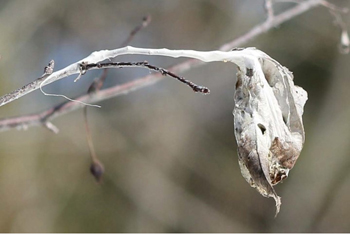This spring, the Maine Forest Service is informing residents of interior Cumberland and York Counties that Maine’s Browntail Moth infestation area may be about to expand into this region, including Gorham. For decades, the moths were concentrated along the immediate coast, but they have recently expanded up several river valleys, including the Kennebec River valley as far as Waterville. Last summer, the moths were seen in increasing numbers in Portland and Falmouth, and some were seen in Standish and Westbrook. The entire area had a mostly dry spring and summer in 2020, followed by a milder than average winter, and this favors increased numbers of the moths.
Browntail Moth caterpillars overwinter in filmy medium-sized white oval webs, known as winter webs. These are often located at the tips of upper branches in the trees that the moths infest, such as apple, crabapple, cherry, birch, and oak. Less typically, winter webs can be found under decks, in stored boats, under house and shed eaves, and other places. The moths begin emerging from the webs and feeding, as soon as new leaves begin growing on the trees in early May.

Close up of overwintering webs of Browntail Moth in ornamental crabapple.
A common lookalike moth is the one which produces the familiar “tents” of tent caterpillars. Tent caterpillar webs are larger, and located further toward the central part of branches, or where branches come together. Also, tent caterpillars have two blue dots on their backs, while mature Browntail Moth caterpillars have orangish-brown hairs, and have white lines and two orange dots on their back.
Browntail Moths can kill host trees by repeatedly eating most of their leaves, but they are primarily considered a public health threat to humans. This is because so many people are allergic to the web and cocoon materials, and to the caterpillars. (All these can remain toxic for years.) Allergic reactions in people can include rashes, welts, and respiratory symptoms. The Forest Service reports that the adult moths themselves are not toxic.
Great care should be used when attempting to remove or dispose of the caterpillars and cocoons, including using gloves and respirator masks, as well as removing outer clothing when entering the home. If burning the webs and cocoons, make sure to use a closed container, so that these toxic materials are not dispersed into the air. The Forest Service has an FAQ webpage with a great deal of information on Browntail Moths, including tips for the safe removal.


